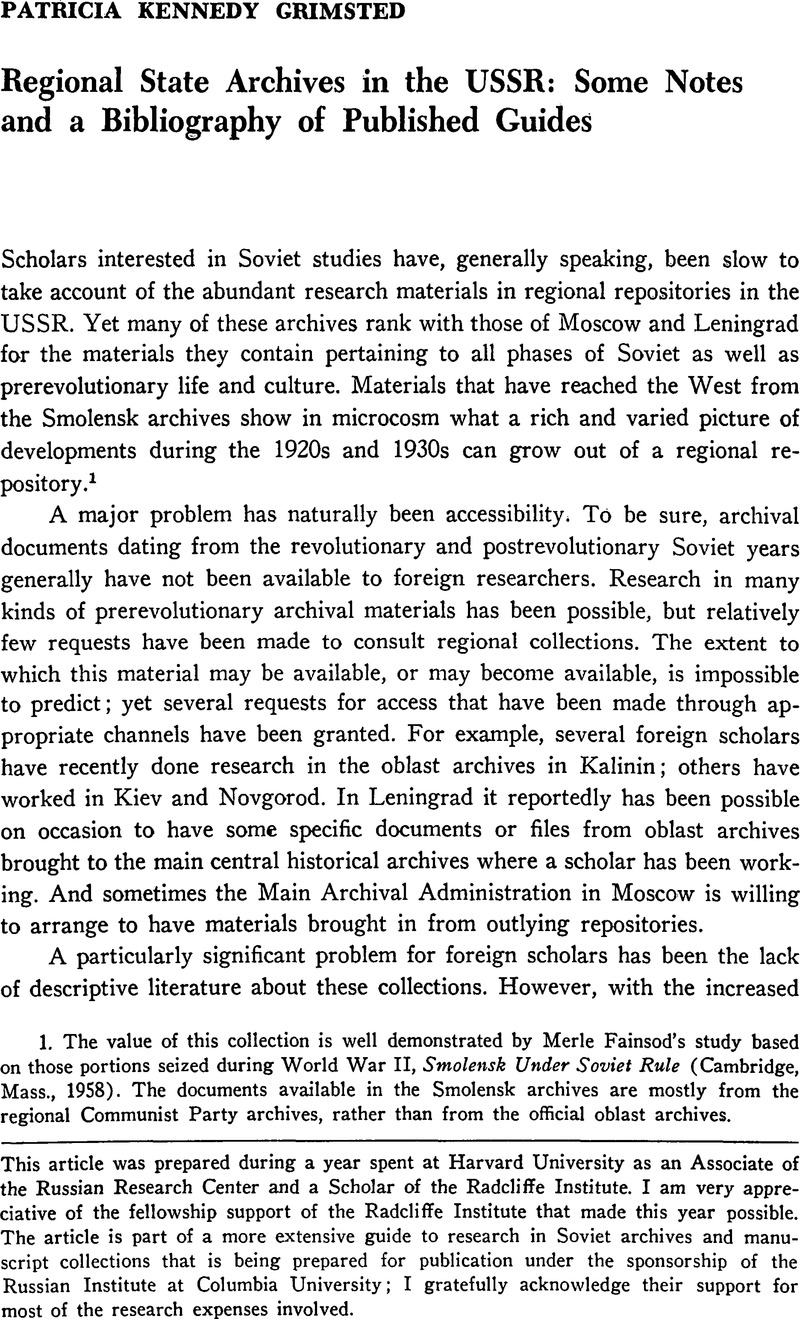No CrossRef data available.
Article contents
Regional State Archives in the USSR: Some Notes and a Ribliography of Published Guides
Published online by Cambridge University Press: 27 January 2017
Abstract

Information
- Type
- Notes and Comment
- Information
- Copyright
- Copyright © Association for Slavic, East European, and Eurasian Studies. 1969
References
1. The value of this collection is well demonstrated by Merle Fainsod's study based on those portions seized during World War II, Smolensk Under Soviet Rule (Cambridge, Mass., 1958). The documents available in the Smolensk archives are mostly from the regional Communist Party archives, rather than from the official oblast archives.
2. The most common form of archival description in the Soviet Union is the putevoditel', which throughout this article will be rendered by“guide.” Normally, a single volume covers a separate archive, giving a general description and history of the collection. It is usually subdivided to cover the major archival subdivisions, such as documents from particular periods or institutions, or a special collection of manuscripts currently housed in the repository; most often the division is between prerevolutionary and postrevolutionary materials (in cases where both are housed together) and between official documents and private collections. The putevoditel', besides outlining the organization of the archives, usually describes or lists the fonds and often gives bibliographical citations of available inventories or published catalogues of individual fonds or manuscript collections; these, in turn, give detailed descriptions of manuscripts and numerically list individual items within a fond. Where a putevoditel’ has not been published, on obsor fondov (survey of fonds), kratkii obsor (short survey), spravochnik (handbook), or similar short description is sometimes available.
3. Articles or pamphlets under fifty pages in length were not counted in arriving at these statistics. The figure for the Library of Congress includes volumes recorded in the card file of the Monthly Index of Russian Accessions as having been received, or in the Process File of the Library of Congress cataloguing department. I am grateful to the library staff for permitting my assistant to check these files, which are normally not open to the public.
4. Actual library catalogues have not been checked beyond those of Harvard University, Columbia University, and the Library of Congress. The figures for other libraries are based on reports to the Monthly Index of Russian Accessions or indications in other union catalogues. Cataloguing, reporting, and filing delays could be responsible for unwarranted low figures for other libraries. (See note 9.)
5. Grimsted, Patricia Kennedy,“Soviet Archives and Manuscript Collections: A Bibliographical Introduction,” Slavic Review, 24 (March 1965): 105–20CrossRefGoogle Scholar.
6. Belov, G. A.,“The Organization of the Archive System in the USSR,” Archives (London), 6 (October 1964): 215 Google Scholar; this article by the director of the Main Archival Administration gives a helpful survey description of the Soviet archival system. I have been unable to locate any complete list published since the 1956 handbook to state archives, Gosudarstvennye arkhivy Soiusa SSR: Kratkii spravochnik, ed. G. A. Belov et al. (Moscow: Glavnoe arkhivnoe upravlenie, 1956).
7. A brief survey of the archives in the different republics—although variations from those listed in the 1956 handbook should be noted—is available in Belov, G. A. and Maksakov, V. V.,“Arkhivy,” in Sovetskaia istoricheskaia entsiklopediia, ed. Zhukov, E. M., 1 (Moscow, 1961): 846–67Google Scholar, but, again, there have been many subsequent changes in nomenclature.
8. In listing geographic names, the Library of Congress uses the spelling authorized by the Board of Geographic Names rather than the official Library of Congress transliteration system. This practice occasionally leads to some confusion in catalogue entries (e.g., Yaroslav instead of Iaroslav). Where discrepancies appear most confusing, alternate spellings are presented immediately below, in parentheses.
9. When a Library of Congress (DLC) holding has been indicated without call number, it means that one had not been assigned at the time of compilation. Outside of Harvard University (MH) and Columbia University (NNC) libraries and the Library of Congress, locations indicated in the present bibliography are at best fragmentary, particularly for the more recent publications. Symbols of other libraries listed are as follows: NjP = Princeton University; CSt-H = Hoover Institution at Stanford University; CU = University of California at Berkeley; InU = Indiana University; IU = University of Illinois; NcU = University of North Carolina. There now exists no single catalogue at the Library of Congress that easily or efficiently provides complete and up-to-date information about library locations for these publications. Older entries have been checked in the Cyrillic Union Catalogue, newer entries in the Catalogue Maintenance Division; a search has also been made of the defunct and fragmentary Slavic catalogue and parts of the National Union Catalogue. The most helpful source, although incomplete for library locations, proved to be the cumulative card file maintained by the office of the Monthly Index to Russian Accessions. I greatly appreciate the advice and assistance of their staff and their permission to use this otherwise closed catalogue. Thanks are due to Jerald Stowell for his assistance in diligently searching through the many catalogues in the Library of Congress complex.
10. I gratefully acknowledge the research assistance of George Weickhardt and Pamela Cocks in bibliographical compilation and the verification of materials in Widener Library at Harvard University. I wish to thank Professor Marc Raeff of Columbia University for making available to me a list of guides to regional archives that he compiled during his visit to the Soviet Union in the spring of 1968 and Eleanor Buist for checking my final list in Columbia University Library. The staff of the Slavic Division of the Library of Congress has been exceedingly helpful throughout this undertaking.

